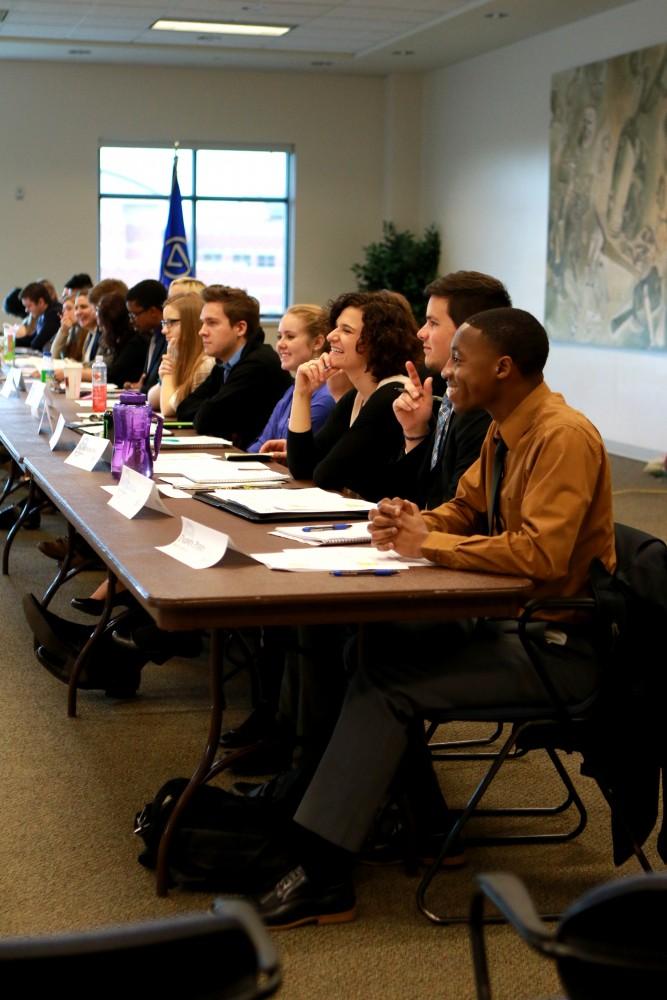Student senate focuses on academic success

The members of the student senate attend a meeting hosted by the Vice President of Business and Finances on Oct. 15 in Allendale, MI. The student senate is made up a wide variety of students.
Oct 19, 2015
Grand Valley State University’s student senate brought in Nancy Giardina and Michael Messner to their meeting on Thursday to discuss student success. Giardina is the vice provost for student success and Messner is the assistant vice provost for student success. Their presentation was broken up into three points of information: updates on framework for student success, student academic success center website and the presentation of the new interactive blueprint for student success.
“If someone were to ask you ‘what’s Grand Valley doing with student success, what does it mean at Grand Valley?’ I wonder if every one of us in the room could articulate that and have it sound pretty the same,” Giardina said to the senators.
She emphasized three components to what she calls the “student success model.” The first component is student academic challenge, the second is student engagement both insides and outside the classroom and the last is student support. Those break down further into four initiative areas: first-year experience, high impact practices, student support services and university-wide initiatives. Those four initiatives are built to help achieve the ideal student success model.
First-year experience strives to help new students stay engaged and happy. Keeping students engaged in school and the community is essential for their success. This includes things like going through the Transitions program, being engaged in co-curricular activities, attending convocation and going through first-year advising and registration.
“Successful students right from year one and through year one, engage in these kind of things,” Giardina said. “The key is make sure you do at least one of these things every year, particularly your first year.”
The second aspect of success is high-impact practices. These are things that help students not only graduate, but also find a job successfully after graduating. They include undergraduate research, studying abroad, leadership roles and intensive writing experiences, such as the SWS courses taken at GVSU. They’re called high-impact because they are meant to have a “tremendous impact” on a student’s college stint. These practices are very desirable to employers.
“The latest research says students that have three or more high-impact experiences by graduation, employers are all over you, they want you,” Giardina said. “At Grand Valley State University, we don’t just give you lip service, we are creating all kinds of places that you can choose to do whatever you want.”
The fourth component was students engaged in student services and university-wide student success initiatives. This includes things like employment on campus, being awarded a scholarship or the Grand Finish, living on campus or participating in the Laker for a Lifetime initiatives. This component is necessary for students to succeed because it engages them with the university and helps them work more in-depth with their community.
The most emphasis is placed on the third item; students engaged in using academic advising and instructional support services. For the students to be successful, GVSU needs to meet the increased program size with an equally increased amount of quality support services. These services can come from the Mary Idema Pew Library, the Fredrick Meijer Writing Center, the Student Academic Success Center or other additional services.
These helpful places offer advising for students of all majors, students with undecided majors, transfer students and non-traditional students. They also offer instructional support in the form of tutors. The university employs about 350 tutors a year.
Messner said this was the fifth year in a row that their lead tutor in the science success center was accepted into medical school. In 2005, GVSU completed about 5,000 hours of tutoring. Last year, an estimated 70,000 hours of tutoring happened at the school. The Student Academic Success Center is working on expanding their reach and giving all students the opportunity to come in and get help.
“There’s sometimes a stigma at coming in and asking for help,” Messner said. “It really is important when you have students in leadership roles and are role models to folks and say ‘it’s OK to pop in and get help, it’s OK.’”
Both Messner and Giardina encouraged the senators to be able to define and explain what it means to be successful and GVSU and how the university aids students to be their most successful not only during college, but after their collegiate careers as well.

























